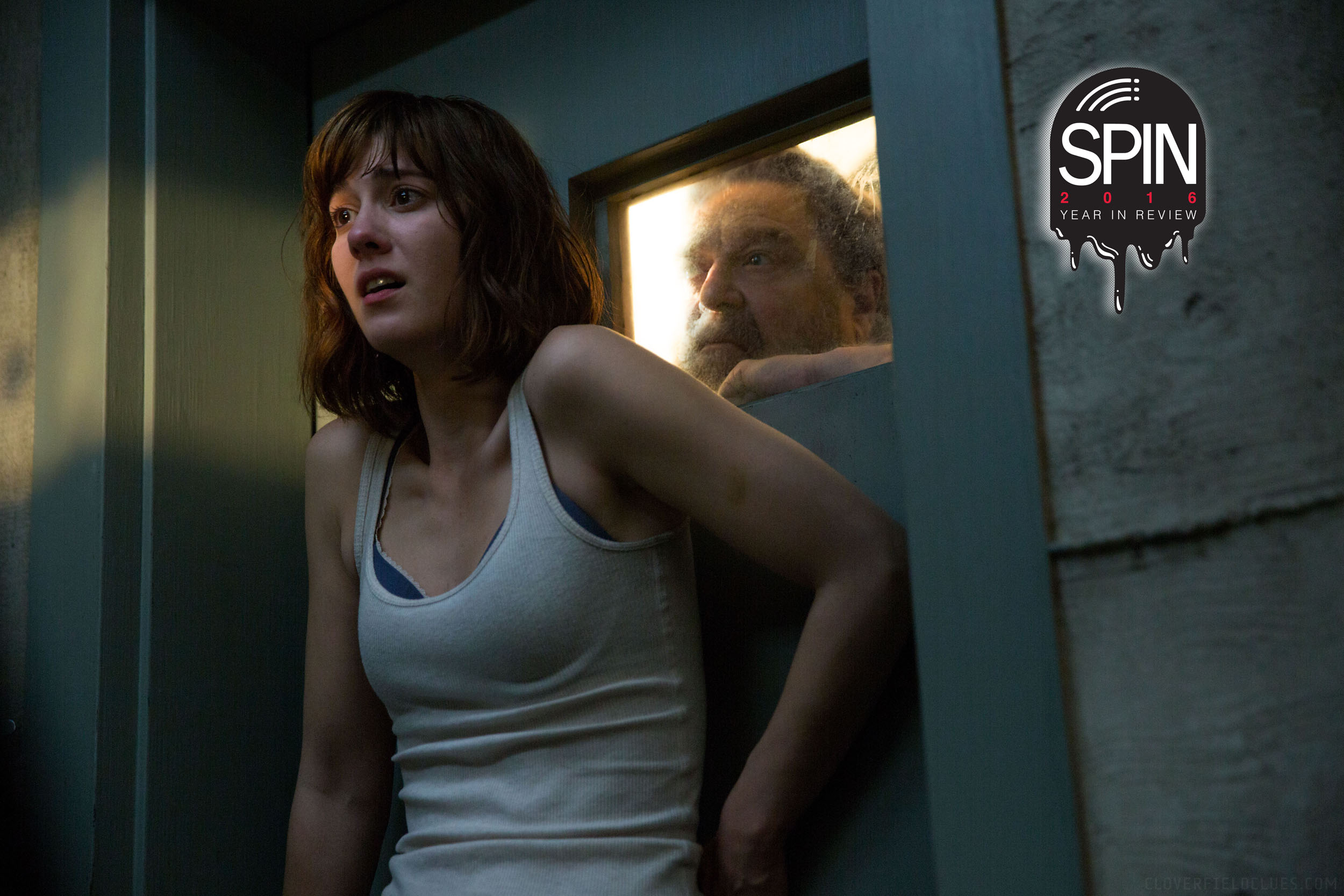There’s a line in a climactic scene of The Invitation, Karyn Kusama’s nightmarish dinner party horror-thriller, that may as well have been the tagline of 2016. The protagonist, Will (Logan Marshall-Green) is giving what amounts to a pep talk to his partner Kira (Emayatzy Corinealdi) before they fight their way out of a tasteful mid-century Los Angeles house that has fallen into cult-suicide chaos. “Remember,” he says, “they’re just people.” It’s a line with at least three readings, all equally troubling and resonant. Relax, they’re not monsters. Goddammit, if only they were monsters. Kira does not look reassured. Nevertheless, the two grip their makeshift weapons and head out.
The Invitation was part of a wave of 2016 horror films whose paranoia and political resonance was so timely as to feel scarily prescient. Over the course of 52 opening Fridays that kept coming no matter how unsettling the week’s headlines, the protagonists we saw on screen often found themselves stuck in cramped, close quarters with people whose dogmatic beliefs posed an imminent physical threat. Watching genre films in 2016 often felt more immediate than watching the news, because the people in genre films at least acknowledged that something very bad was happening to them, and reacted accordingly. Even the too-big-to-fail Marvel Cinematic Universe was embroiled in its own incoherent civil war, while the barely-contained literal rebellion of Rogue One: A Star Wars Story was just the big-budget cherry on top of this tumultuous year.
Effective filmmakers, no matter their genre or taste, put their fingers in the air, feel for a current, and then make art that either complements or pushes against it. They distill the world they live in, which is why there’s no such thing as an apolitical film. Independent sci-fi and horror films have a leg up when it comes to responding to Our Times — they’re usually cheaper and quicker to produce, and tend to get distribution more readily. Violence and terror sell, which is why genre fiction has long been a Trojan Horse for barely-veiled cultural alarmism.
As 2016 draws to a close and everyone starts making their best-of lists, I’ve read and heard some critics lament that we don’t have a film that directly speaks to our post-election reality. We do — they just came well before the election, and well before Oscar season, in the traditional schlock dumping ground of spring. (The most on-the-nose horror film of the year–that would be The Purge: Election Year–was written long before our president-elect took his ride down the golden escalator, making it all the more interesting.)

Also Read
Death Be Not Proud
There was a decent share of jump-scare and boogeyman driven horror releases throughout the year, but 2016’s most effectively scary movies were also the most mundane. Like The Invitation, Jeremy Saulnier’s punks-vs.-Nazis gorefest Green Room was another deceptively low-concept escape-the-house thriller–except in its case, the house was a hardcore white supremacist venue deep in the Oregon woods. Green Room was one of the most violent films of the year, and it was a hard watch even before a mob of “alt-right” white nationalists trolled the country into voting for a presidential candidate endorsed by the KKK. But now it seems impossible to ignore the catalyst to its mayhem: An anarchist punk band, hard up for cash, sell out their beliefs and play for a house full of skinheads. As the skinhead-in-command (Patrick Stewart) predicts, it doesn’t end well.
As oppressive as the film’s bloodshed is, it still feels like an aspirational fantasy, insofar as confronting someone face-to-face feels impossibly straightforward compared to the social media analog. Its primal level of discourse is nonpartisan, but the film is unambiguous about its morality (Nazis=bad, which counts as an incendiary opinion these days). And Saulnier makes the band fight for their ideals, which theretofore they’d only screamed at underattended house shows. The shattering of their bubble doesn’t make them rethink their beliefs; it clarifies them.
Green Room was not the only film to not-so-subtly make monsters out of militantly regressive humans. Dan Trachtenberg’s 10 Cloverfield Lane pitted urban-dwelling woman (Mary Elizabeth Winstead) against a rural doomsday prepper who takes her to his underground bunker after what he says was an apocalyptic disaster wipes out the surface. The proximity of the prepper community to the Alex Jones-listening manosphere is no accident, though the script deftly avoids calling that element out by name. And it’s no accident that Trachtenberg cast John Goodman — lovable, solid, occasional life-of-the-mind-showing John Goodman — as bunkerkeeper Howard, a dad gone bad. There’s a queasy-making predatorial undertone to Howard’s enforced patriarchy, made all the more uncomfortable by Goodman’s familiar frame. As the third act of the film ratchets up to what feels like a well-worn escape-the-bunker climax, the script zags, realizing that it’s not enough for Winstead’s character to escape Goodman’s. There will always be a bigger monster, and Michelle’s real victory is not when she holds her own against it, but when she is strong enough to defend those more vulnerable than her.
I could recite the plots of countless 2016 movies in a way that makes them obvious political metaphors in hindsight. The adolescent heroine of The Witch who escapes her puritanical family to see the world and know the taste of butter. The deaf female writer who is taunted via text by a man who’s invaded her home in Hush. The blind veteran in Don’t Breathe whose crumbling Detroit house turns into a death trap for a teen girl who just wants enough money to move to California. Did we go to the movies looking for these parallels, or did the movies give them to us? That’s a trick question, because we always bring our anxieties to the movies, even if it’s only with the hope that they’ll be drowned out by the sound of clanking metal or the sparkliness of Emma Stone’s eyes. But genre films ride waves of escapism vs. dissent from decade to decade, and we are currently at a cresting peak of the latter. It started building with the destroy-all-elites rebellion of the Hunger Games films, and got more lethal with the first two Purge films, deceptively marginal and grimy things that for all their imperfections struck a chord. Compare the franchise-friendly brutality of Rogue One to the peak escapism of the Lord of the Rings trilogy, which let audiences still shaken from 9/11 and the Iraq War hide out in the multiplex with beautiful elves and assured righteous victory for 3 or 4 hours at a time.
Another way of looking at these changing tides is where and how filmmakers decide to put their rage and anguish. Will it wind up in a clever talkie like The Big Short or In The Loop or a kitchen sink drama like Fruitvale Station? Or do such nuanced, writerly approaches feel inadequate — do they need attack dogs and rape basements and satanic goats? When the filmmaking of dissent arms itself with a genre, the films become leaner, the objectives more primal. Escape the house. Kill the Nazis. Defeat the body snatchers. Put on the glasses. The threat is other people. They’re just people.
At first glance, the collective imagery and events of the genre films of 2016 paints a bleak picture with a huge body count. And yet, I felt electrified by them, even such schlocky junior high satire as The Purge: Election Year. Because the horror movies knew. They were one of the few pieces of mass media that weren’t downplaying how upsetting everything was. Having your anger seen and acknowledged by the movies is a powerful thing, even if the movies ultimately can’t protect you. That the anger these films were dealing with was felt primarily by women was nothing new for horror, but relatively novel for political outrage.
2016 gave us a wealth of immensely entertaining horror and sci-fi films, not in spite of their political tenor but because of it. The joke’s on anyone who would wish away a contemporary point of view from Rogue One or Arrival or 10 Cloverfield Lane. That’s the subversive power of genre film, for better or worse: you can hide the most radical anarchy in it and the candy coating is still irresistible, even to those it directly condemns. The films of 2016 hacked and slashed throughout our entire miserable election cycle, and Donald J. Trump hadn’t even been elected president yet. I can’t wait to see how 2017 schlock season processes that development.




